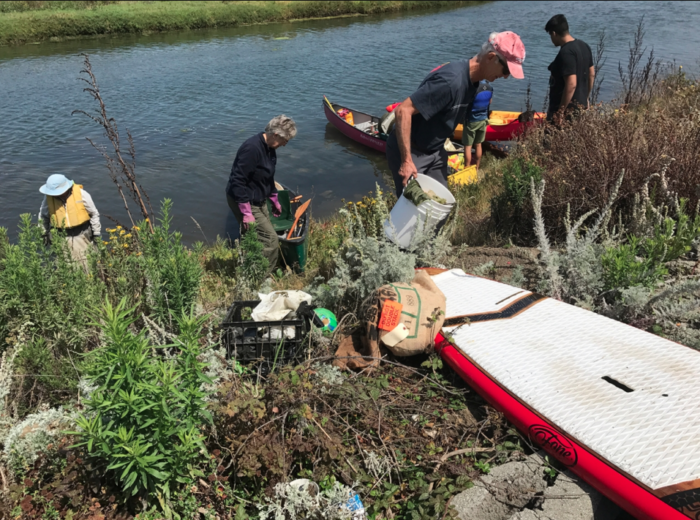
Blog: Finding Sanctuary – Plastics threaten the marine sanctuary by: Lisa Wooninck

Save Our Shores volunteers clean up the Pajaro River. (Save Our Shores/Contributed)
By: Lisa Wooninck
Published: Santa Cruz Sentinel, February 18, 2023
Published: Monterey Herald, March 4, 2023
Nine atmospheric rivers hit California from Dec. 27 to Jan. 16, with an average of 12 inches of rainfall, including nearly 40 inches in Santa Cruz. Almost half of the rainfall on the Central Coast entered Monterey Bay National Marine Sanctuary (MBNMS) through rivers and streams, carrying with it millions of tons of natural and human-made debris.
Human debris comes in many forms, much of it consisting of lightweight and mass-produced plastic products used by Californians every day.
Perhaps you have seen plastic bags and bottles, food wrappers, cigarette butts, and straws in our rivers and creeks or clogging storm drains after a rainfall. This debris is not only seen on land and on our beaches. Sanctuary scientists, while conducting scuba and remotely operated vehicle (ROV) research, have observed a myriad of ocean debris from the surface down to depths of 10,000 feet — bottles, buckets, derelict fishing gear, a shipping container, 100-year-old china, a wheelchair and even a washing machine.
Aside from the eyesore marine debris evokes, plastics may have acute and chronic effects on the marine ecosystem and its inhabitants. Debris entangles whales, is ingested by wildlife, disturbs the seafloor, and releases harmful chemicals during their decay.
Microplastics are a significant threat to both human health and the marine ecosystem, and their distribution is global. For example, MBNMS staff and partners detected microplastics in every ocean sample taken from nearshore and offshore locations of the sanctuary.
Fish and shellfish consume microplastics, which then make their way into our food supply. Ingestion of microplastics by marine wildlife may lead to starvation and even endocrine disruption, which can alter the normal functioning of hormones in their bodies and result in several health problems.
Sanctuary staff aims to understand the amount, types and sources of marine debris through research, and focuses on ways to work with coastal and inland communities to reduce these inputs. The sanctuary is coordinating with NOAA’s Marine Debris Program and local farmers to reduce the amount of agricultural plastics that enter the sanctuary.
Future plans include characterizing the amount and sources of microplastics in Monterey Bay beach sand, working with local agencies to monitor microplastics in wastewater effluent, and developing education and outreach programs to inform the public about the problem. One such early product is an educational StoryMap on marine debris in the sanctuary.
Lisa Wooninck became the superintendent of NOAA’s Monterey Bay National Marine Sanctuary in 2021. She has a doctorate in ecology and evolutionary biology, and marine biology from UC Santa Barbara. She can be reached at lisa.wooninck@noaa.gov. To learn more about the sanctuary, visit https://montereybay.noaa.gov/.
